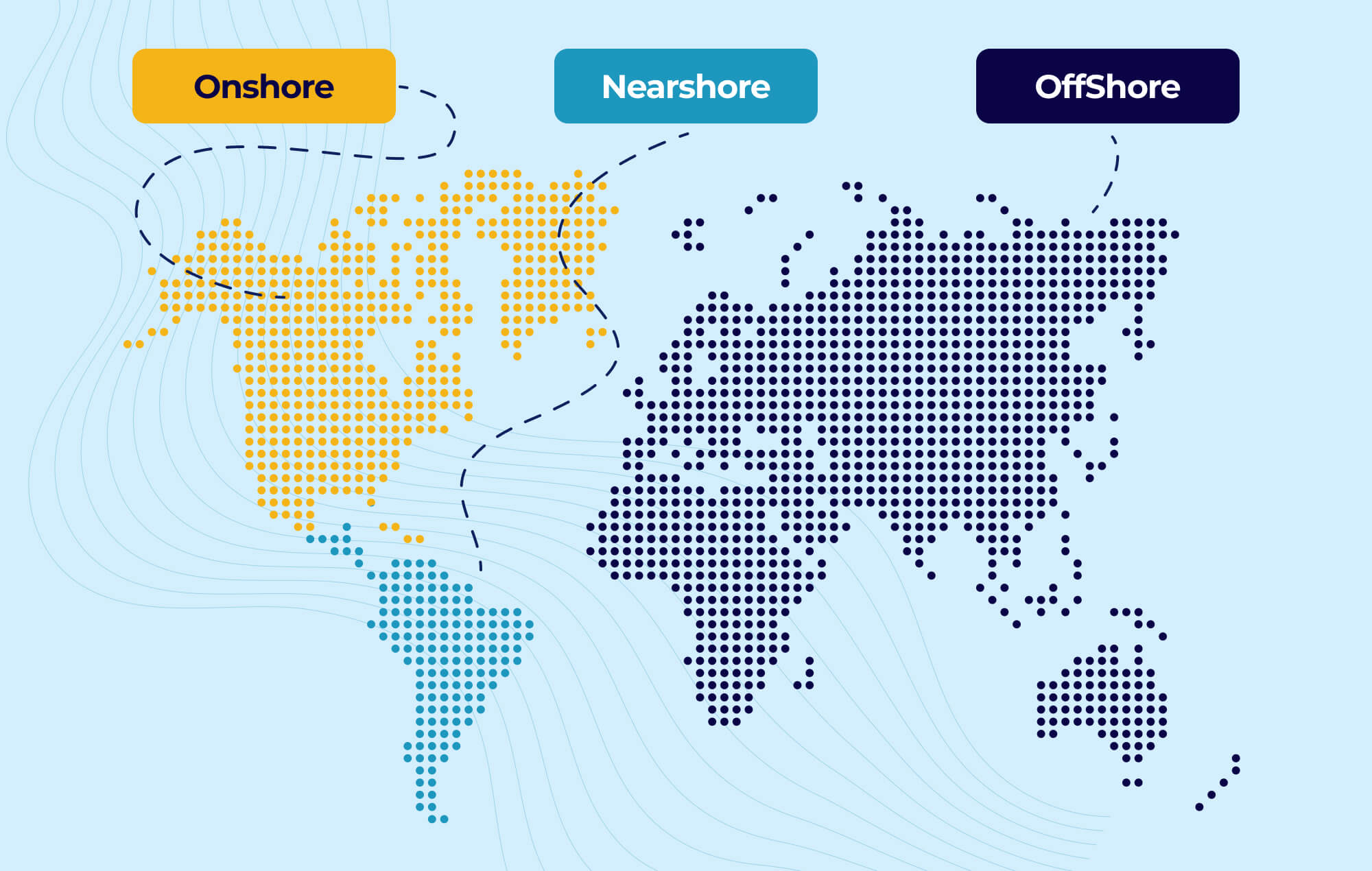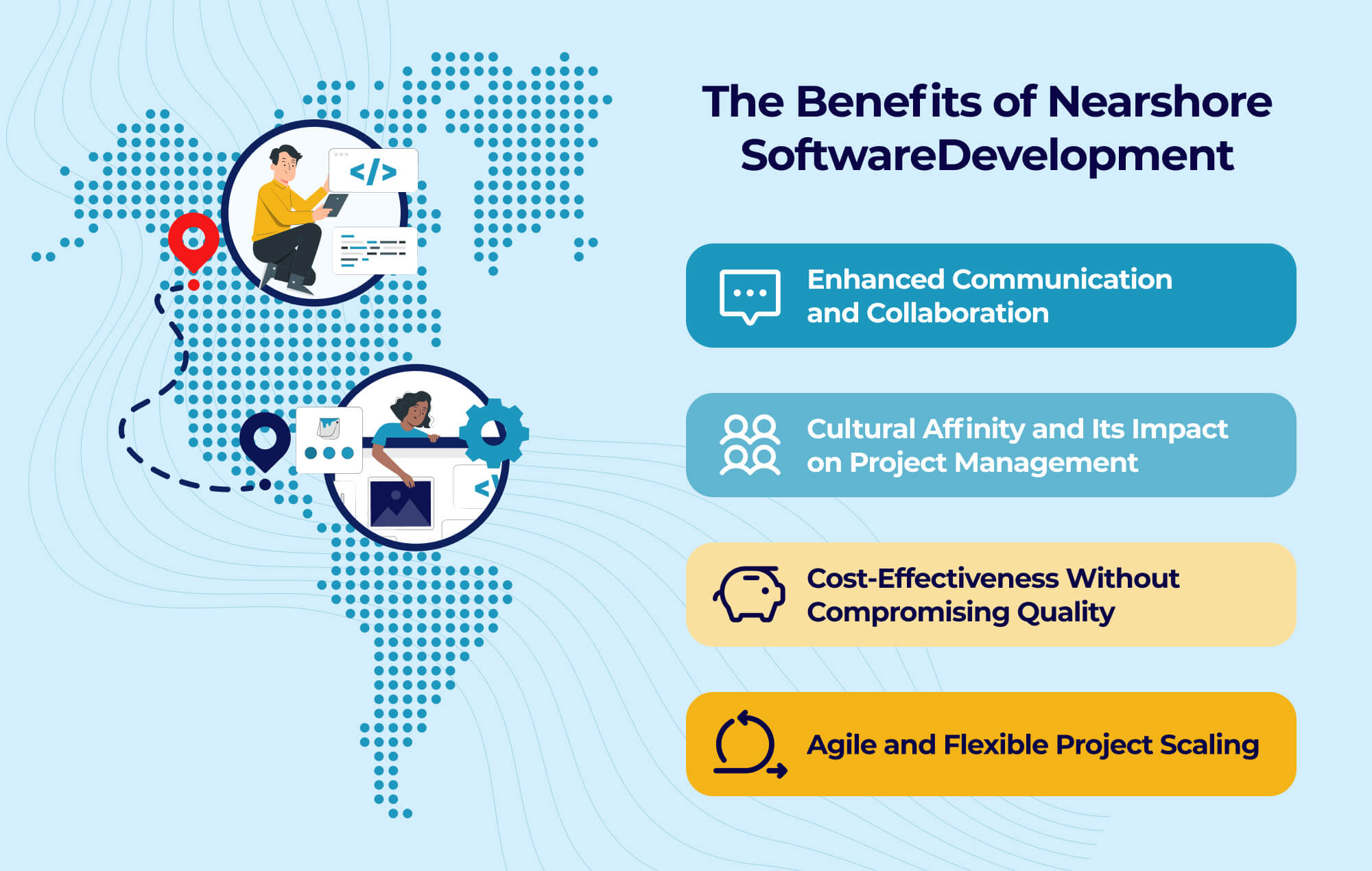Table of Contents
Outsourcing has become a cornerstone of modern software development strategies, offering businesses many benefits, from cost savings to increased efficiency. With these advantages, more and more companies are turning to third-party teams to build their custom software, many of which operate in foreign locations.
However, if the concept of working across time zones to develop a custom solution for your business doesn’t sound particularly ideal, then nearshore outsourcing might be the best choice for you. This will enable your business to unlock all the same benefits of offshore development but with the added convenience of collaborating with a team closer to home.
In this article, we explore how nearshore software development can propel your business forward while also acknowledging potential hurdles you may come across during the development process. By the end, you’ll gain a comprehensive understanding of nearshore development in 2025, fully equipped with effective strategies to harness its exceptional potential.
Keep reading to learn more.
What Is Nearshore Software Development?
Nearshore software development involves outsourcing software development tasks to a neighboring or nearby country, typically in the same or a similar time zone. For example, a British company might outsource development to a French team.
This approach offers various advantages, such as cultural and linguistic proximity, similar business practices, and easier collaboration compared to offshore outsourcing. As a result, nearshore software development is increasingly popular for companies seeking cost-effective solutions while maintaining quality and efficiency in their software development projects.
The Evolution of Nearshore Outsourcing in the Tech Industry
Nearshore outsourcing in the tech industry has evolved significantly, thanks to technological advancements, global economic shifts, and changing business needs. Initially serving as a cost-saving measure, it has matured with advancements in high-speed internet, cloud computing, and collaboration tools, facilitating seamless communication and project management. This has enabled greater agility and efficiency in software development processes, allowing teams to work collaboratively across borders in real time.
Moreover, shifts in global economics have led to the emergence of new nearshore outsourcing destinations, with countries in Latin America, Eastern Europe, and Asia-Pacific offering competitive advantages in terms of skilled talent pools, favorable business environments, and cultural compatibility. With this diversification of options, your company can now select nearshore partners based on specific project requirements and strategic objectives.
Key Differences Between Nearshore, Onshore, and Offshore Software Development
When navigating software development outsourcing, it’s important to fully understand the nuances of nearshore, onshore, and offshore models. These differences are primarily based on geographic location, cost implications, cultural alignment, communication dynamics, and project management strategies. Here, we delve into each aspect, providing valuable insights to help you make the best outsourcing decisions for your business.
Geographic Location and Time Zone
Nearshore software development positions teams in neighboring countries with similar time zones, enabling real-time collaboration and minimizing communication barriers. This proximity enhances project efficiency by offering easier coordination of tasks and meetings.
Onshore development occurs within your own country, maintaining synchronous working hours and immediate accessibility. On the other hand, offshore teams operate in distant time zones, necessitating careful scheduling to accommodate time differences and ensure effective communication across borders.
Cost Implications
Nearshore outsourcing offers a balance between quality and affordability, with moderate costs reflecting regional labor rates. Onshore development typically incurs higher expenses due to local wages and operational overheads, while offshore software development outsourcing often provides the most cost savings. However, offshoring may also involve additional expenses related to communication and coordination efforts, increasing its overall costs.
Cultural and Linguistic Alignment
Nearshore outsourcing fosters collaboration, as you’ll be working with developers whose cultural backgrounds are similar to your own. You may even be fluent in the same language, facilitating smoother communication and overall understanding. With onshore development, leveraging a domestic team’s seamless linguistic and cultural alignment also provides enhanced cohesion and efficiency.
If outsourcing your project to an offshore team, however, you may encounter various challenges stemming from cultural and language differences. This will require you to take proactive measures to bridge gaps and ensure effective collaboration.
Collaboration and Communication
Nearshore development enables close collaboration with your development team due to their geographic proximity. Because you are in the same time zone, outsourcing to a nearshore team ensures real-time communication and efficient project management.
Onshore teams also offer direct and immediate communication channels, fostering rapid decision-making and problem-solving throughout the development process. But when working with an offshore team, you will need to leverage robust communication tools and strategies to overcome time zone barriers and ensure effective collaboration and project progress.
Project Management and Control
Nearshore outsourcing provides your business with greater control over project management, with opportunities for on-site visits and direct oversight of development activities. Onshore development also allows for comprehensive control and supervision, as you can closely monitor progress and address issues promptly.
However, offshore outsourcing demands robust project management frameworks and communication channels to maintain control and ensure alignment with project objectives and timelines.
The Benefits of Nearshore Software Development
Nearshore software development offers numerous advantages, including proximity to your country, cultural alignment, and similar time zones. This proximity fosters efficient communication, collaboration, and project management, resulting in smoother workflows and improved project outcomes.
Enhanced Communication and Collaboration
Due to similar time zones, working with a nearshore team facilitates real-time communication and collaboration with developers. This alignment streamlines decision-making processes, reduces delays, and enhances project efficiency, leading to faster delivery times and improving your overall satisfaction.
Cultural Affinity and Its Impact on Project Management
Cultural affinity in nearshore software development promotes better understanding, trust, and collaboration between you and your development team. Shared cultural values, norms, and communication styles facilitate smoother project management processes, fostering stronger relationships and reducing the risk of misunderstandings or conflicts.
Cost-Effectiveness Without Compromising Quality
Nearshore outsourcing offers cost-effective solutions without compromising quality. By leveraging skilled talent in neighboring countries with lower labor costs, your business can achieve significant savings while maintaining high standards of workmanship and product excellence. This balance between affordability and quality is a key advantage of nearshore software development.
Agile and Flexible Project Scaling
Nearshore development teams offer agility and flexibility in scaling projects according to your business’ evolving needs. Whether ramping up or downsizing resources, nearshore outsourcing provides the scalability required to adapt to changing project requirements, market demands, and budget constraints, ensuring optimal resource allocation and project success.
Disadvantages of Nearshore Software Development
While nearshore software development offers numerous benefits, it’s essential to also acknowledge and understand its potential drawbacks. In this section, to ensure you are able to make informed outsourcing decisions, we explore the challenges and limitations you may encounter when opting for nearshore development solutions.
Limited Talent Pool
Nearshore outsourcing, while advantageous in terms of geographic proximity, may cause you to face limitations in accessing a diverse talent pool. This is particularly pronounced in specialized or niche areas where specific skills are in high demand. Consequently, the availability of top-tier expertise may be restricted, potentially hindering innovation and the ability to tackle complex project requirements effectively.
Cultural and Language Differences
Despite being in close geographic proximity, you may still encounter significant cultural and language differences when working with a nearshore team. For instance, variances in communication styles, work practices, and business norms could lead to misunderstandings and misalignment between you and your development team. Such disparities may impede collaboration, compromise project clarity, and impact the overall quality of deliverables.
Overdependence on the Provider
Overreliance on a single nearshore provider for all your software development needs can pose risks to your business. Should the provider encounter operational challenges, resource shortages, or quality issues, your project could face disruptions, delays, or compromised outcomes. Diversifying partnerships or establishing contingency plans can help mitigate these risks and ensure project continuity.
Intellectual Property Concerns
Nearshore outsourcing arrangements may raise apprehensions regarding the protection of intellectual property (IP). For example, in regions with less robust legal frameworks or enforcement mechanisms, concerns about IP theft, unauthorized use, or breaches of confidentiality may arise. As a result, it’s crucial to implement stringent contractual safeguards, confidentiality agreements, and security measures to mitigate these risks and safeguard your proprietary technology and sensitive information.
Higher Prices Compared to Other Models
While nearshore outsourcing typically offers cost savings compared to onshore alternatives, it may still entail higher prices relative to offshore options. Factors such as regional labor costs, overhead expenses, and market competitiveness can influence pricing structures. This means it’s imperative to carefully evaluate the overall value proposition and weigh the benefits of proximity and cultural alignment against the associated costs to ensure you make informed outsourcing decisions.
Top Nearshore Software Development Locations
When it comes to nearshore development, certain countries have emerged as prime outsourcing destinations, offering a combination of strategic advantages and favorable conditions. Mexico, boasting a robust IT infrastructure and a vast pool of tech talent, stands out for its geographical proximity to the United States, particularly in cities like Mexico City, Guadalajara, and Monterrey.
Meanwhile, Costa Rica’s stable political climate, strong educational system, and burgeoning tech industry make it an attractive option, with San Jose serving as a hub for innovation. Thanks to strategic government incentives and investments in STEM education, Colombia is also appealing, with cities like Bogotá, Medellín, and Cali fostering vibrant tech ecosystems.
How to Choose the Right Nearshore Software Development Partner
Selecting the ideal nearshore software development partner requires careful consideration of various factors. You should begin by assessing the partner’s reputation, portfolio, and client testimonials and evaluating their technical capabilities, project management methodologies, and scalability. It’s also important to examine their communication channels, cultural compatibility, and geographic proximity to ensure optimal communication.
Criteria for Selecting a Nearshore Development Company
When evaluating nearshore development companies, it’s vital to prioritize factors such as expertise in relevant technologies, project management practices, and industry-specific experience. You should then assess their track record of successful projects, adherence to deadlines, and ability to accommodate project requirements. For best results, you should also consider factors like scalability, flexibility, and cultural alignment.
The Role of Technical Expertise and Industry Experience
Technical expertise and industry experience are crucial considerations when selecting a nearshore development partner. As a result, you should look for companies with a proven track record in relevant technologies, frameworks, and methodologies and prioritize partners with experience in your industry. This will ensure that they can effectively offer valuable insights and tailored solutions to meet your specific needs and challenges.
Evaluating Communication Skills and Cultural Fit
Effective communication and cultural fit are essential for successful collaboration with a nearshore development partner. By thoroughly assessing the development team’s communication channels, responsiveness, and language proficiency prior to hiring, you can foster a collaborative partnership and seamless interaction throughout the project lifecycle. You should also consider cultural factors such as work culture, values, and communication styles to ensure alignment and minimize misunderstandings.
How Idea Maker Can Help You Nearshore Your Software Development Project
At Idea Maker, we offer comprehensive nearshoring software development options that drive business growth and innovation. With our extensive experience in software development, our team delivers seamless collaboration, expert skill, and hiqh-quality solutions tailored to your needs. By partnering with Idea Maker, you can optimize your project’s success and realize the benefits of nearshore development. To get started, schedule a free consultation with us today.















